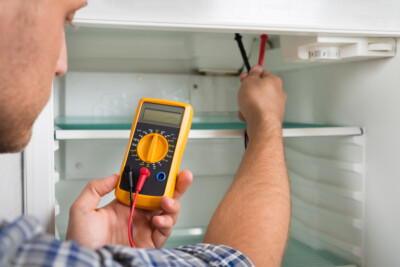My Ice Maker Isn’t Making Ice?
Your ice maker may fail if there is ice in the mold but it won’t eject. Often the ice may not be completely frozen when it comes out of the ice maker. When the temperature in the freezer is too high, it may be too hot for it to form or remain frozen.
If the freezer is too hot, the ice cubes will melt, appear smaller, or deform. If the ice bin is not used often or has become too full, thawing and refreezing can cause ice cubes to accumulate. A frozen water line may result in small ice cubes or no ice. Air in the system may cause the dispenser to drip or form small/empty ice cubes.
If the water filter is installed incorrectly, it may reduce the flow of water to the ice maker, resulting in small ice cubes, little or no ice production. Flushing the system is necessary every time the filter is changed or the first time the refrigerator is installed in the water supply line. When replacing the water filter, the system must be flushed before it operates properly. While the pipe can be cleaned or thawed and water pressure adjusted, a failed valve must be replaced.
If the water supply valve has sufficient pressure and power is supplied, but the ice maker does not fill with ice making water, replace the water supply valve. If the water pressure is sufficient, use a multimeter to check the power supply to the water supply valve. Make sure the water inlet valve is not closed or restricted by a bracket or clasp. The water supply line can be removed from the back of the refrigerator, and the pressure is adjustable.
Make sure the water supply line is not kinked behind or under the refrigerator (it’s better to use 1/4″ copper tubing rather than a plastic fill line to prevent kinks). If the plumbing is frozen, turn off the refrigerator and locate the water supply shut-off valve under the sink or behind the refrigerator. Find the water supply stopcock behind the refrigerator or under the sink, close it, unscrew the copper pipe from the back of the refrigerator, put the copper pipe into a bucket, open the faucet and see if water is leaking. When checking the water supply line, make sure that the water supply is properly connected to the cold water network and that the water supply stopcock is fully open.
To make sure you have clean ice and unobstructed water flow, you should replace your freezer water filter according to the manufacturer’s recommendations. Sub-Zero recommends replacing your refrigerator water filter every 6-12 months to avoid blockages that restrict water flow and ice production. If the water filter becomes clogged or dirty, it will prevent water from entering the ice maker and the ice maker will not produce ice.
If it’s been a while since you changed the filter, it’s probably clogged and water can’t flow into the ice maker (you’ll likely notice the ice cubes get smaller or smaller before it gets completely clogged). If the plumbing is clogged, water cannot come out and ice does not form. Not enough, it can also make sure that the water line does not fill the ice mold.
If a lot of ice freezes, no new ice can form, and the waterline can also be a problem because it can’t fill the sample. A less serious failure can occur if too much water causes the ice tray to fill with ice. Make sure to remove as many ice cubes as possible from the tray, as the remaining ice cubes can cause the water in the small fill tube to freeze. Ice buildup will cause the water inlet pipe to freeze, and if the water inlet pipe freezes repeatedly after defrosting, it may be a valve failure.
The water fill valve opens for a few seconds to fill the ice mold and the cycle repeats. If the ice maker is not producing ice, but you see the ice ejector lever move and a buzzing sound is heard for about 10 seconds, the water valve is calling for water that is not coming out.
Look for ice cubes in the mold and make sure the motor that turns the pusher arm is running. The hot water will melt frozen ice cubes without adding chemicals to the ice maker tray, making it safe to resume ice making in the ice maker assembly immediately. If your ice maker uses tap water (straight water), make sure the water flows freely and reaches the portable ice maker.
A defective faucet valve—the small device that connects the ice maker’s water supply hose to the water hose from the ice maker’s water supply hose to the water hose—may cause problems where the ice maker’s inlet hose connects to the water hose. If your freezer is working properly, you have the control lever in the ON position, but it still doesn’t work or make ice, it could be a problem with the ice maker unit as a whole or the ice maker solenoid valve. water manufacturer in the back. Either of these two factors can cause the Sub-Zero refrigerator to not produce ice due to limited water supply. If your home’s water pressure is below 40 psi, ice production may be delayed or stopped.
If less than 3/4 cup of water is dispensed, the water pressure is likely insufficient to make ice. The water supply valve may fail if the water supply valve is blocked by mineral deposits preventing the valve from opening.
To schedule ice maker repairs in Oklahoma City contact Appliance Repair OKC Services by calling 405-378-4566 or visit our website at https://www.okcappliance.com to also our Google business page at https://cutt.ly/YEnc8qk. Call now!
The post My Ice Maker Isn’t Making Ice? appeared first on Appliance Repair OKC Services | Best Appliance, Washing Machine Repair Company in Oklahoma.


No comments:
Post a Comment